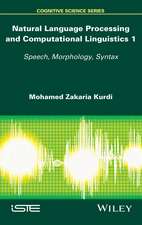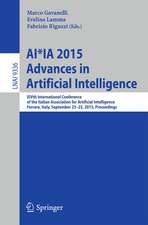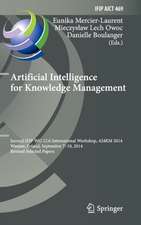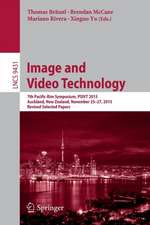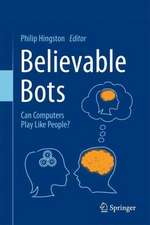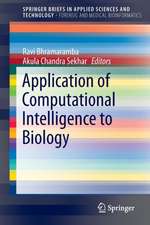Conceptual Graphs and Fuzzy Logic: A Fusion for Representing and Reasoning with Linguistic Information: Studies in Computational Intelligence, cartea 306
Autor Tru Hoang Caoen Limba Engleză Hardback – 15 iul 2010
| Toate formatele și edițiile | Preț | Express |
|---|---|---|
| Paperback (1) | 641.49 lei 6-8 săpt. | |
| Springer Berlin, Heidelberg – 5 sep 2012 | 641.49 lei 6-8 săpt. | |
| Hardback (1) | 646.30 lei 6-8 săpt. | |
| Springer Berlin, Heidelberg – 15 iul 2010 | 646.30 lei 6-8 săpt. |
Din seria Studies in Computational Intelligence
- 20%
 Preț: 449.37 lei
Preț: 449.37 lei - 20%
 Preț: 1158.26 lei
Preț: 1158.26 lei - 20%
 Preț: 986.66 lei
Preț: 986.66 lei - 20%
 Preț: 1452.76 lei
Preț: 1452.76 lei - 20%
 Preț: 168.78 lei
Preț: 168.78 lei - 20%
 Preț: 1291.10 lei
Preț: 1291.10 lei - 18%
 Preț: 1112.30 lei
Preț: 1112.30 lei - 20%
 Preț: 565.39 lei
Preț: 565.39 lei - 20%
 Preț: 649.28 lei
Preț: 649.28 lei - 20%
 Preț: 1047.73 lei
Preț: 1047.73 lei - 20%
 Preț: 1578.96 lei
Preț: 1578.96 lei - 20%
 Preț: 643.50 lei
Preț: 643.50 lei - 20%
 Preț: 657.49 lei
Preț: 657.49 lei - 20%
 Preț: 993.28 lei
Preț: 993.28 lei - 20%
 Preț: 990.80 lei
Preț: 990.80 lei - 20%
 Preț: 989.96 lei
Preț: 989.96 lei - 20%
 Preț: 1165.69 lei
Preț: 1165.69 lei - 20%
 Preț: 1444.52 lei
Preț: 1444.52 lei - 20%
 Preț: 1041.96 lei
Preț: 1041.96 lei - 20%
 Preț: 1047.73 lei
Preț: 1047.73 lei - 20%
 Preț: 1046.06 lei
Preț: 1046.06 lei - 18%
 Preț: 2500.50 lei
Preț: 2500.50 lei - 20%
 Preț: 989.13 lei
Preț: 989.13 lei - 20%
 Preț: 1165.69 lei
Preț: 1165.69 lei - 20%
 Preț: 1164.05 lei
Preț: 1164.05 lei - 20%
 Preț: 1042.79 lei
Preț: 1042.79 lei - 20%
 Preț: 1460.19 lei
Preț: 1460.19 lei - 18%
 Preț: 1403.52 lei
Preț: 1403.52 lei - 18%
 Preț: 1124.92 lei
Preț: 1124.92 lei - 20%
 Preț: 1039.47 lei
Preț: 1039.47 lei - 20%
 Preț: 1008.11 lei
Preț: 1008.11 lei - 20%
 Preț: 1045.25 lei
Preț: 1045.25 lei - 20%
 Preț: 1275.42 lei
Preț: 1275.42 lei - 20%
 Preț: 1040.32 lei
Preț: 1040.32 lei - 20%
 Preț: 988.32 lei
Preț: 988.32 lei - 20%
 Preț: 1169.79 lei
Preț: 1169.79 lei - 20%
 Preț: 1162.37 lei
Preț: 1162.37 lei - 20%
 Preț: 1059.26 lei
Preț: 1059.26 lei - 20%
 Preț: 1164.05 lei
Preț: 1164.05 lei - 20%
 Preț: 1166.52 lei
Preț: 1166.52 lei - 20%
 Preț: 1459.38 lei
Preț: 1459.38 lei - 18%
 Preț: 1005.74 lei
Preț: 1005.74 lei - 20%
 Preț: 997.38 lei
Preț: 997.38 lei - 20%
 Preț: 1055.94 lei
Preț: 1055.94 lei - 20%
 Preț: 1284.47 lei
Preț: 1284.47 lei - 20%
 Preț: 994.08 lei
Preț: 994.08 lei - 20%
 Preț: 1048.72 lei
Preț: 1048.72 lei - 20%
 Preț: 1066.02 lei
Preț: 1066.02 lei - 20%
 Preț: 943.78 lei
Preț: 943.78 lei - 20%
 Preț: 1173.10 lei
Preț: 1173.10 lei
Preț: 646.30 lei
Preț vechi: 807.87 lei
-20% Nou
Puncte Express: 969
Preț estimativ în valută:
123.67€ • 134.76$ • 104.21£
123.67€ • 134.76$ • 104.21£
Carte tipărită la comandă
Livrare economică 23 aprilie-07 mai
Preluare comenzi: 021 569.72.76
Specificații
ISBN-13: 9783642140860
ISBN-10: 3642140866
Pagini: 240
Ilustrații: 240 p. 77 illus.
Dimensiuni: 155 x 235 x 24 mm
Greutate: 0.44 kg
Ediția:2010
Editura: Springer Berlin, Heidelberg
Colecția Springer
Seria Studies in Computational Intelligence
Locul publicării:Berlin, Heidelberg, Germany
ISBN-10: 3642140866
Pagini: 240
Ilustrații: 240 p. 77 illus.
Dimensiuni: 155 x 235 x 24 mm
Greutate: 0.44 kg
Ediția:2010
Editura: Springer Berlin, Heidelberg
Colecția Springer
Seria Studies in Computational Intelligence
Locul publicării:Berlin, Heidelberg, Germany
Public țintă
ResearchCuprins
Fuzzy Conceptual Graphs.- Annotated Fuzzy Logic Programming.- Fuzzy Conceptual Graph Programming.- Modelling and Computing with Generally Quantified Statements.- Approximate Knowledge Retrieval.- Natural Language Query Understanding.
Recenzii
From the reviews:
“This research monograph is devoted to the idea of fuzzy conceptual graphs, their analysis, algorithms and applications. … One of the outstanding features of the monograph is a formal and systematic coverage of the fundamental concepts. Overall, the book can serve as a valuable, well-structured reference book for all those interested in the effective representation and processing of fuzzy information.” (Witold Pedrycz, Zentralblatt MATH, Vol. 1208, 2011)
“This research monograph is devoted to the idea of fuzzy conceptual graphs, their analysis, algorithms and applications. … One of the outstanding features of the monograph is a formal and systematic coverage of the fundamental concepts. Overall, the book can serve as a valuable, well-structured reference book for all those interested in the effective representation and processing of fuzzy information.” (Witold Pedrycz, Zentralblatt MATH, Vol. 1208, 2011)
Textul de pe ultima copertă
The capacity for humans to communicate using language allows us to give, receive, and understand information expressed within a rich and flexible representational framework. Moreover, we can reason based on natural language expressions, and make decisions based on the information they convey, though this information usually involves imprecise terms and uncertain facts. In particular, conceptual graphs invented by John Sowa and fuzzy logic founded by Lofti Zadeh have the common target of representing and reasoning with linguistic information. At this juncture, conceptual graphs provide a syntactic structure for a smooth mapping to and from natural language, while fuzzy logic provides a semantic processor for approximate reasoning with words hav-ing vague meanings. This volume is the combined result of an interdisciplinary research programme focused on the integration of conceptual graphs and fuzzy logic for various knowledge and information processing tasks that involves natural language. First, it is about fuzzy conceptual graphs and their logic programming foundations, as a graph-based order-sorted fuzzy set logic programming language for automated reasoning with fuzzy object attributes and types. Second, it extends conceptual graphs with general quantifiers and develops direct reasoning operations on these extended conceptual graphs, which could be mapped to and from generally quantified natural language statements. Third, it defines similarity and subsumption measures between object types, names, and attributes and uses them for approximate retrieval of knowledge represented in graphs. Finally, it proposes a robust ontology-based method for understanding natural language queries using nested conceptual graphs.
Caracteristici
Fusing conceptual graphs and fuzzy logic into a formalism for computing with words; fusing conceptual graphs and fuzzy logic into a formalism for computing with words State-of-the-Art book Written by leading experts








